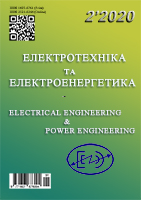The influence of nonlinear load on the autonomous electrical network at parallel work of the active power filter
DOI:
https://doi.org/10.15588/1607-6761-2020-2-5Keywords:
active power filter, pq-theory power, synchronous generator, electrical energy quality, non-linear loadAbstract
Purpose. The purpose of the article is to investigate the modes of operation of a three-phase active power filter in the composition of an autonomous electrical network when connected to a network of three-phase nonlinear load of different spectral character.
Methodology. For the research, the provisions of the pq-theory of power, the theory of electrical circuits, the theory of automatic control, mathematical modeling in the Matlab package were used.
Findings. The graphs and spectral composition of the mains voltage and load current have been obtained, which makes it possible to evaluate the effectiveness of using a power active filter in the filtration mode as part of an autonomous electrical network, which is a synchronous generator.
Originality. The efficiency of the parallel operation of a power active filter in the filtration mode with a synchronous generator at an abruptly variable nonlinear load is proved.
Practical value. The use of the proposed technique will make it possible to create a three-phase power active filter for its use in autonomous electrical networks, represented by a synchronous generator with automatic regulation of the excitation voltage.
References
[1] Сherednyk, N.G., Bialobrzeski, O.V. (2016). Doslidgen’ya regymu synhron’ogo generator kogeneratchiynoyi ustanovky pry paralel’niy ta avtonomniy roboti z urahuvan’yam yavyscha nasychen’ya magnitnoyi systemy generatora [The study of the mode of synchronous generator cogeneration unit in parallel and autonomous work considering the phenomenon of magnetic saturation of generator system]. Electrical Engineering and Power Engineering, 1, 49-56.
[2] Bialobrzeski, O.V., Сherednyk,, N.G. (2016). Avtomatyzovani systemy keruvan’ya v elektroenergetytchi [Automated control systems in power engineering]. Kremenchuk, PP Scherbatyh O.V., 204.
[3] Beresyn, O.O., Boyko, A.O., Radimov, S.M. (2012). Osoblyvosti pobudovy vyprobuval’noyi stantchiyi synhron’yh generatoriv, scho pratchyu’t’ zi zmin’oyu chastotoyu obertan’ya [Features of construction of the proof-of-compliance test station for variable speed synchronous generators]. Electrotechnic and computer systems, 7(83), 42-46.
[4] Kotelenets, N.F., Bogachev, A.V., Ezhov, E.V. (2014). The method and apparatus of synchronization excited synchronous generator with the network, Elektrichestvo, no. 4, pp. 50– 54.
[5] Frolov, M.Yu., and Fishov, A.G. (2017). Identifikatsiya elektricheskikh parametrov sinkhronnogo genera-tora pri vklyuchenii v raspredelitel'nuyu set' [Identification of electrical parameters of a synchronous generator when connected to the distribution network] Problems of the regional energetics, no. 1 (33), pp. 32-39.
[6] Vlasenko, R., Bialobrzheskyi, O., and Gladyr, A. (2018). Analysis of three-phase parallel active power filter operation mode with arc furnace active power’s fluctuations, 2018 IEEE 3rd International Conference on Intelligent Energy and Power Systems (IEPS), Kharkiv, pp. 80-84, doi: 10.1109/IEPS.2018.8559547.
[8] Vaynshteyn, R.A. (2010). Matematicheskie modeli elementov elektroenergeticheskih sistem v raschetah ustanovivshihsya i perehodnyih protsessov [Mathematical models of electric power systems elements in the calculation of steady-state and transient], Tomsk, Russia, 114 p.
[9] Chernyih, I.V. (2008). Modelirovanie elektrotehnicheskih ustroystv v MATLAB, SimPowerSystems i Simulink [Simulation of electrical devices in MATLAB, SimPowerSystems and Simulink], SPbSMTU, Sankt-Peterburg, Russia, 288p.
[10] Akagi, H., Watanabe, E. H., Aredes, M. Instantaneous Power Theory And Applications To Power Conditioning, Wile-IEEE Press., 2007. – 379 p. ISBN 978-0-470-10761-4.
[11] Tugay, D., Zhemerov, G., Korneliuk, S., & Kotelevets, S. (2019). Three theoremes of the instantaneous power theory. Paper presented at the 2019 IEEE 2nd Ukraine Conference on Electrical and Computer Engineering, UKRCON 2019 - Proceedings, 289-294. doi:10.1109/UKRCON.2019.887990
[12] Agunov, A. V. (2009). Upravlenie kachestvom electroenergiyi pri nesinusoidal’nyh rezhymah [Power quality management with non-sinusoidal modes], SPbSMTU, Sankt-Peterburg, Russia, 134p.
[13] Vlasenko, R.V., Bialobrzeski, O.V. (2014). Porivnyan’ya metodiv kompensatchiyi neaktyvnoyi potugnosti tryfaznym sylovym aktyvnym fil’trom z adaptyvnym releynym regulyatorom strumu [Adaptive control of current controller relay for three-phase active power filter]. Electrical Engineering and Power Engineering, 2, 20-27.
[14] Zagirnyak, M., Maliakova, M., and Kalinov, A. (2016). Analysis of operation of power components compensation systems at harmonic distortions of mains supply voltage, Paper presented at the Joint International Conference - ACEMP 2015: Aegean Conference on Electrical Machines and Power Electronics, OPTIM 2015: Optimization of Electrical and Electronic Equipment and ELECTROMOTION 2015: International Symposium on Advanced Electromechanical Motion Systems, pp. 355-362. DOI:10.1109/OPTIM.2015.7426958
[15] Vlasenko, R.V., Bialobrzeski, O.V. (2019). Vplyv potugnosti spotvoren’ya na parametry elementiv sylovoyi chastyny tryfaznogo sylovogo aktyvnogo fil’tra [The influence of the distortion power on the parameters of the power components of a three-phase active power filter]. Scientific journal "Transactions of Kremenchuk Mykhailo Ostrohradskyi National University", 1(114), 14-19.
[16] Burlaka, V. V., Podnebennaya, S. K., and Gulakov, S. V. (2018). Residential uninterruptible power supply system with renewable energy sources and battery pack. Paper presented at the 2018 IEEE 3rd International Conference on Intelligent Energy and Power Systems, IEPS 2018 - Proceedings, pp. 125-128.
Downloads
Published
How to Cite
Issue
Section
License
Copyright (c) 2020 R.V. Vlasenko, O.V. Bialobrzheskyi

This work is licensed under a Creative Commons Attribution 4.0 International License.
Creative Commons Licensing Notifications in the Copyright Notices
Authors who publish with this journal agree to the following terms:
Authors retain copyright and grant the journal right of first publication with the work simultaneously licensed under aCreative Commons Attribution License that allows others to share the work with an acknowledgement of the work's authorship and initial publication in this journal.
Authors are able to enter into separate, additional contractual arrangements for the non-exclusive distribution of the journal's published version of the work (e.g., post it to an institutional repository or publish it in a book), with an acknowledgement of its initial publication in this journal.
Authors are permitted and encouraged to post their work online (e.g., in institutional repositories or on their website) prior to and during the submission process, as it can lead to productive exchanges, as well as earlier and greater citation of published work.

